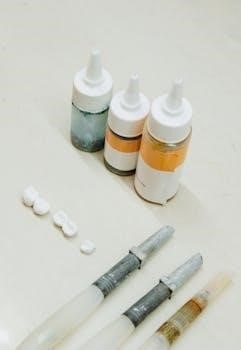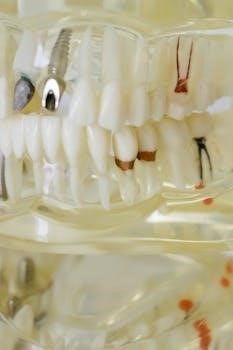Raptor Liner is a durable, two-part urethane coating designed for protecting surfaces like truck beds, offering a tough, weather-resistant barrier. Popular among DIYers and professionals, it provides long-lasting protection and a professional finish with proper application.
Overview of Raptor Liner
Raptor Liner is a highly durable, two-part urethane coating designed to provide a protective barrier for various surfaces. It is commonly used for truck beds, Jeeps, and other vehicles, offering excellent resistance to abrasion, UV exposure, and harsh environmental conditions. Available in black and tintable options, Raptor Liner can be applied via spraying, rolling, or brushing, making it versatile for different projects. Its tough, textured finish ensures long-lasting protection and a professional appearance, making it ideal for both DIY enthusiasts and professionals seeking a reliable coating solution.
Importance of Proper Application
Proper application of Raptor Liner is crucial for achieving a durable and professional finish. Incorrect techniques can lead to uneven coatings, peeling, or reduced longevity. Ensuring the surface is clean, sanded, and free of grease is essential for optimal adhesion. Following the recommended mixing ratios and curing times is also vital to avoid defects. Proper preparation and application not only enhance the liner’s performance but also protect the underlying surface from damage, making it a cost-effective solution for long-term protection and maintenance.
Benefits of Using Raptor Liner
Raptor Liner is a top choice for surface protection due to its exceptional durability and versatility. It provides a tough, weather-resistant barrier that withstands heavy use and harsh conditions. The liner is ideal for truck beds, off-road vehicles, and industrial surfaces, offering long-lasting protection against rust, abrasion, and UV damage. Its 2-part urethane formula ensures a strong bond and a professional finish. Raptor Liner is also easy to apply, making it a cost-effective solution for DIY projects and professional applications alike. Its versatility and performance make it a superior choice for protecting various surfaces.
Materials and Tools Needed
The Raptor Liner kit includes 4 liters of product, a spray gun, and hardener. Additional tools like sandpaper, masks, and eye protection are essential for a smooth application process.
Raptor Liner Kit Contents
The Raptor Liner kit typically includes 4 liters of the protective coating product, a spray gun, and a 1-liter hardener. It also contains 4x750ml bottles of the base coat and detailed instructions for application. The spray gun requires 8 CFM and 50-60 PSI for optimal performance. Additional components may vary, but the standard kit provides everything needed for a professional-grade application. Ensure all items are included before starting the project to avoid delays.
Additional Tools and Equipment
Beyond the kit, you’ll need sandpaper for surface preparation, a mask, gloves, and eye protection for safety. Drop cloths or plastic sheets are essential for protecting surrounding areas. A compressor with adequate CFM and PSI is required for the spray gun; Brushes or rollers may be needed for detailed work. Cleaning supplies like acetone or thinner are necessary for equipment maintenance. Ensure all tools are ready to avoid delays during application. These additional items will help achieve a professional, smooth finish and ensure proper safety throughout the process.
Safety Gear Requirements
Proper safety gear is essential when applying Raptor Liner. Wear a respirator or mask to avoid inhaling strong fumes and particles. Protective gloves prevent skin irritation and ensure a secure grip on tools. Safety glasses or goggles are crucial to shield eyes from overspray. A well-ventilated workspace is mandatory to prevent fume buildup. Avoid loose clothing that could catch on equipment. Keep a fire extinguisher nearby, as the product is flammable. Proper safety equipment ensures a safe and successful application process, protecting both you and your surroundings from potential hazards.
Surface Preparation
Proper surface preparation is crucial for Raptor Liner adhesion and durability. Clean, sand, and degrease the area to ensure a smooth, even application. Tape and cover surrounding areas to protect them from overspray; For bare metal, apply a 4-1 epoxy primer before coating. Repair any damaged or rusty spots to ensure optimal results. A well-prepared surface guarantees a professional finish and long-lasting protection.
Cleaning the Surface
Cleaning the surface is the first step in preparing for Raptor Liner application. Use a degreaser to remove dirt, oil, and grease, ensuring a clean base for adhesion. Avoid harsh chemicals that might damage the substrate. Scrub the area with a stiff brush to eliminate loose debris. Rinse thoroughly with water and allow the surface to dry completely. Proper cleaning ensures a strong bond between the surface and the liner, preventing peeling or uneven coverage. A clean surface is essential for achieving a professional, long-lasting finish with Raptor Liner.
Sanding and Smoothing
Sanding and smoothing are critical steps in preparing the surface for Raptor Liner application. Start with medium-grit sandpaper (80-120 grit) to remove rust, imperfections, and old coatings. Progress to finer grits (240-320) for a smooth finish. Sand all areas thoroughly, ensuring evenness. Use a sanding block for large surfaces and focus on edges and corners. After sanding, inspect the surface for any remaining imperfections and address them. Wipe away dust with a tack cloth to ensure a clean, debris-free surface for the liner. Proper sanding ensures better adhesion and a professional, long-lasting finish.
Taping and Covering Areas
Taping and covering areas not meant to be coated is essential for a clean, professional finish. Use high-quality masking tape to outline the edges of areas you want to protect, such as trim, handles, or decals. Cover larger areas with paper or plastic sheeting, securing them tightly with tape. Ensure the tape is pressed firmly to prevent seepage. Apply tape carefully to avoid wrinkles or air pockets. Double-check all covered areas before applying the Raptor Liner to ensure proper alignment and coverage. This step prevents unwanted coating and maintains the appearance of protected surfaces.
Dealing with Bare Metal
When applying Raptor Liner to bare metal, proper preparation is crucial for optimal adhesion and durability. Begin by degreasing the surface to remove any contaminants. Lightly sand the area to create a rough texture, ensuring better bonding. Apply a 4-1 epoxy primer to the bare metal before coating with Raptor Liner. This step is essential for creating a strong bond and preventing rust. Allow the primer to dry completely according to the manufacturer’s instructions. Once dry, proceed with applying the Raptor Liner, following the recommended two-coat process with 60 minutes of drying time between coats for a professional finish.
Repairing Damaged Areas
For damaged areas, start by cleaning and sanding the surface to remove loose material. Use a wire brush to ensure the area is smooth and free of debris. Apply a thin coat of Raptor Liner directly to the damaged area, allowing it to dry completely before applying additional coats. For deeper scratches or chips, repeat the process until the area is evenly covered. This method ensures a seamless repair and maintains the protective barrier, restoring the surface to its original durability and appearance.
Application Methods
Raptor Liner can be applied by spraying, rolling, or brushing. Each method ensures a durable, professional finish, suitable for various surfaces and project sizes easily.
Spraying Raptor Liner
Spraying Raptor Liner is a popular method for achieving a smooth, even finish. Use an air pressure of 60 PSI (4 Bar) and apply two coats, allowing 45-60 minutes between each. The kit includes a spray gun requiring 8 CFM. This method is ideal for large surfaces like truck beds, ensuring quick coverage and professional results. Proper surface preparation and taping are essential to avoid overspray. For best results, maintain consistent spraying distance and speed. This technique is highly efficient for DIY projects and small-scale applications, delivering a durable, weather-resistant coating.
Rolling Raptor Liner
Rolling Raptor Liner is a straightforward method for applying the coating, especially for those without spray equipment. Use a high-quality foam roller to ensure smooth, even coverage. This technique is ideal for smaller surfaces or detailed areas. Apply thin, consistent layers, allowing 45-60 minutes between coats. Rolling is perfect for DIY projects, offering a durable, textured finish. It’s suitable for truck beds, trailers, and other surfaces needing protection. Proper surface preparation is essential for optimal adhesion and longevity. This method ensures a professional-looking result with minimal tools, making it a great alternative to spraying.
Brushing Raptor Liner
Brushing Raptor Liner is an effective method for small, detailed areas or touch-ups. Use a high-quality brush with synthetic fibers to ensure smooth application. This technique is ideal for tight spaces and intricate surfaces. Apply thin, even coats, allowing 45-60 minutes between layers. Brushing is perfect for DIY projects, offering precise control and a durable finish. It works well on metal, wood, and other surfaces. Proper surface preparation is crucial for optimal adhesion. Brushing Raptor Liner is a simple, efficient way to achieve professional results without specialized equipment, making it a great option for smaller-scale applications and detailed work.
Mixing Instructions
Mixing Raptor Liner involves combining the base coat with a hardener in the correct ratio. Follow the instructions carefully to ensure proper chemical bonding and durability.
Proper Mixing Techniques
Proper mixing is crucial for Raptor Liner’s performance. Mix the base coat and hardener in a 2:1 ratio using a mixing stick. Ensure thorough blending for 2 minutes, scraping the sides and bottom of the container. Avoid air bubbles by mixing slowly and deliberately. Use the mixture immediately after preparation to prevent curing in the container. Always mix in a well-ventilated area, wearing protective gear. Proper mixing ensures a strong, durable finish and optimal adhesion to the surface being coated.
Adding Hardeners
Adding hardeners to Raptor Liner is essential for proper curing and adhesion. Mix the hardener with the base coat in the recommended 2:1 ratio. Pour the hardener slowly into the base, stirring continuously with a mixing stick. Avoid over-mixing, as this can introduce air bubbles. Ensure the mixture is smooth and free of streaks. Use the mixture immediately after preparation to prevent premature curing. Always follow the product’s instructions for exact measurements. Proper hardener addition ensures a durable, long-lasting finish. Wear gloves and work in a well-ventilated area for safety.
Incorporating Anti-Slip Additives
To enhance traction and durability, anti-slip additives can be incorporated into the Raptor Liner. Add one full bag of the additive to a mixed bottle of Raptor Liner and shake thoroughly for 2 minutes. This ensures even distribution of the texture. Apply the mixture immediately using a spray gun, roller, or brush. The additive creates a textured surface, improving grip and resistance to wear. Avoid overloading the coating with too much additive, as it may compromise the finish. Follow the manufacturer’s guidelines for optimal results and a professional-grade application.
Application Process
Apply the first coat evenly, allow proper drying time, then proceed with subsequent coats for optimal coverage and durability. Follow instructions carefully for a professional finish.
Applying the First Coat
Start by ensuring the surface is clean, sanded, and properly prepared. Mix the Raptor Liner components thoroughly, following the instructions provided in the kit. Use the spray gun at 60 PSI or apply with a roller or brush. Work in steady, even strokes to cover the entire surface. For best results, apply the first coat thinly and evenly, avoiding drips or uneven coverage. Allow the first coat to dry completely according to the recommended time on the product instructions before proceeding to the next step. Proper application ensures a strong bond and durable finish.
Allowing Proper Drying Time
Allowing proper drying time is crucial for a durable and even finish. After applying the first coat, let it dry for 45-60 minutes, or as specified in the product instructions. Ensure the surface is touch-dry before proceeding to the next coat. Factors like temperature and humidity can affect drying time, so ideal conditions are essential. Avoid rushing this step, as incomplete drying can lead to uneven results or poor adhesion. Proper drying ensures the Raptor Liner adheres correctly and achieves its maximum protective properties. Patience here is key to a professional-quality finish.
Applying Subsequent Coats
After the first coat has dried, apply subsequent coats following the same preparation and technique. Typically, 2-3 coats are recommended for optimal durability. Allow 45-60 minutes between coats, or as specified in the product instructions. Ensure even coverage by maintaining consistent spraying or rolling patterns. Avoid over-application, as this can lead to peeling or unevenness. Properly align each coat to achieve a smooth, professional finish. For best results, maintain the recommended air pressure of 60 PSI when spraying. This step ensures a strong, long-lasting protective barrier for your surface.
Curing and Drying
Raptor Liner typically cures within 24 hours, but full hardness may take up to 72 hours, depending on temperature and humidity. Follow instructions for optimal results.
Recommended Curing Time
Raptor Liner typically cures within 24 hours under normal conditions, but full hardness may take up to 72 hours. Temperature and humidity significantly impact drying time. For optimal results, ensure the surface remains undisturbed during the curing process. Light use can resume after 24 hours, but avoid heavy exposure or stress for at least 72 hours. Proper curing ensures maximum durability and adhesion, making it essential to follow instructions carefully for a professional finish.
Optimal Drying Conditions
Raptor Liner dries best in temperatures between 60°F and 90°F (15°C to 32°C) with low humidity. Avoid applying in direct sunlight or high moisture. Ensure good air circulation for even drying. Ideal conditions promote proper curing and adhesion, ensuring a durable finish. Avoid extreme temperatures or moisture, as they can slow drying or cause uneven results. Proper environmental control is crucial for achieving the best outcome with Raptor Liner applications.
Post-Application Steps
After applying Raptor Liner, inspect the finish for imperfections. Touch up any uneven areas and reinstall hardware once fully cured. Ensure all components are securely fastened.
Inspecting the Finish
After applying Raptor Liner, inspect the surface for imperfections like bubbles, uneven areas, or peeling. Use a utility knife to carefully remove any excess material. Check for complete coverage and ensure the liner adheres properly to the substrate. If necessary, lightly sand rough spots or touch up thin areas with additional coats. Allow the liner to cure fully before reinstalling hardware or using the surface. Proper inspection ensures a professional, durable finish that withstands heavy use and environmental exposure.
Touching Up Imperfections
For minor imperfections like thin spots or bubbles, use a small brush to apply additional Raptor Liner directly to the affected area. Lightly sand the edges to feather them into the surrounding finish. If necessary, apply another full coat, ensuring proper mixing and application techniques. Allow the liner to cure according to the recommended time before using the surface. Touch-ups should blend seamlessly with the original finish, maintaining the liner’s durability and appearance. Addressing imperfections promptly ensures a professional, long-lasting result.
Reinstalling Hardware
After the Raptor Liner is fully cured, reinstall any hardware like tie-downs, plugs, or panels. Ensure all surfaces are clean and free of debris before reattaching. Apply a small amount of Raptor Liner to the hardware’s contact points for a secure seal. Tighten all components properly to avoid damage to the liner. Reinstallation should be done carefully to maintain the liner’s integrity and ensure a professional finish. Allow the liner to cure completely before exposing the surface to heavy use or harsh conditions.
Maintenance and Care
Regularly clean the Raptor Liner with mild soap and water to maintain its appearance. Avoid using harsh chemicals or abrasive materials that could damage the coating. For tough stains, use a soft-bristle brush and rinse thoroughly. Avoid exposing the liner to gasoline, diesel, or bleach, as these can degrade the material. Touch up scratches or chips promptly to prevent further damage and ensure long-term durability.
Cleaning the Raptor Liner
Regular cleaning is essential to maintain the Raptor Liner’s appearance and durability. Use mild soap and water to wipe down the surface, avoiding harsh chemicals or abrasive materials. For tough stains, apply a soft-bristle brush gently to scrub the area before rinsing thoroughly. Avoid using gasoline, diesel, or bleach, as these can damage the coating. Regular maintenance ensures the liner remains resistant to wear and tear, preserving its protective qualities and aesthetic appeal over time.
Avoiding Damaging Substances
To maintain the integrity of the Raptor Liner, avoid exposure to harsh chemicals like gasoline, diesel, or bleach, as they can degrade the coating. While Raptor Liner is highly durable and resistant to many substances, prolonged contact with solvents or acids can compromise its protective properties. Regular cleaning with mild soap and water is recommended to prevent buildup and maintain the liner’s performance. Avoid using abrasive materials or high-pressure washes, as they may scratch the surface. Proper care ensures the liner remains effective and retains its appearance over time.
Troubleshooting Common Issues
Common issues with Raptor Liner include peeling, bubbling, or uneven coating. These can often be resolved by ensuring proper surface preparation, mixing, and application techniques.
Addressing Uneven Coating
Uneven coating can occur due to improper mixing, insufficient surface preparation, or incorrect application techniques. To fix this, lightly sand the affected area and reapply a thin, even coat. Ensure the surface is clean, dry, and free of contaminants before reapplying. Using the correct spray gun or roller settings is crucial for a smooth finish. Allow the recommended drying time between coats to prevent pooling or uneven distribution. If the issue persists, check the hardener ratio and environmental conditions, as temperature and humidity can affect results. Proper technique and patience are key to achieving a professional-looking finish.
Fixing Peeling or Bubbling
Peeling or bubbling in a Raptor Liner application is often caused by moisture, oil, or poor surface adhesion. To fix this, start by thoroughly cleaning the area with a degreaser and sanding it lightly to ensure proper bonding. Remove any loose or bubbled material and feather the edges for a smooth transition. Reapply the liner, following the mixing and spraying instructions carefully. Ensure the surface is completely dry and free of contaminants before reapplication. For severe cases, applying a primer first may improve adhesion. Allow the recommended curing time before exposing the surface to stress or weather conditions.
Advanced Techniques
Raptor Liner can be customized with color matching and anti-slip additives for enhanced durability. It’s suitable for various surfaces, including industrial, marine, and off-road applications, ensuring versatility and professional results.
Color Matching and Customization
Raptor Liner offers customization options, including color matching, to achieve a personalized finish. Use tintable base coats and additives to create unique shades or textures. For color matching, mix the base coat with compatible colorants according to the manufacturer’s instructions. Anti-slip additives can also be incorporated for enhanced traction. This versatility allows users to tailor the liner’s appearance and functionality to specific needs, ensuring a professional and customized result. Proper mixing and application techniques are essential for achieving the desired color and performance.
Applying Raptor Liner to Different Surfaces
Raptor Liner is versatile and can be applied to various surfaces, including metal, aluminum, fiberglass, wood, and concrete. For best results, ensure the surface is clean, sanded, and free of grease or rust. It is ideal for truck beds, Jeeps, marine surfaces, and industrial equipment. The liner can be sprayed, rolled, or brushed, depending on the surface type. While it adheres well to most materials, some surfaces may require additional preparation, such as priming. Always follow the manufacturer’s guidelines for specific surface applications to ensure a durable and long-lasting finish.
Applying Raptor Liner is a straightforward process that offers durable, long-lasting protection for various surfaces. With proper preparation and application, it ensures a professional, weather-resistant finish.
Final Tips for a Professional Finish
For a professional finish, ensure proper surface preparation, including cleaning and sanding, to achieve optimal adhesion. Apply thin, even coats, allowing adequate drying time between layers. Use the recommended air pressure and avoid high temperatures to prevent orange peel. Inspect the finish immediately after application to address any imperfections. Allow the final coat to cure fully before exposing the surface to heavy use. Regular maintenance, such as cleaning and avoiding harsh chemicals, will extend the liner’s durability. Following these steps ensures a sleek, long-lasting protective coating.
Long-Term Durability and Performance
Raptor Liner offers exceptional long-term durability, providing a protective barrier against harsh conditions, including UV exposure, chemicals, and abrasion. Its two-part urethane formula ensures a strong bond to surfaces, extending their lifespan. Properly applied, it resists peeling and cracking, maintaining its appearance and functionality over time. Ideal for truck beds, Jeeps, and industrial surfaces, Raptor Liner is a reliable choice for withstanding heavy use and outdoor elements, ensuring surfaces remain protected and look great for years to come.









